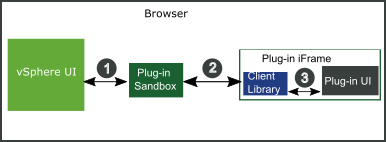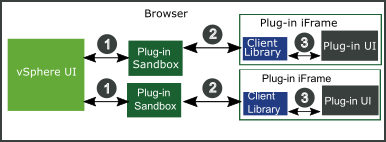The vSphere Client user interface loads both its own components and the components belonging to the plug-in user interface. The vsphere-ui service reads the plug-in manifest file to determine where it should insert plug-in components in the user interface.
The user interface components loaded in the browser are organized as shown in the following diagram.
1 | |
2 | |
3 |
The plug-in user interface operates within its own IFrame, isolated from other plug-ins. The plug-in loads a copy of the vSphere Client JavaScript API client library, which is its sole connection to other client code. The plug-in code communicates with the client library code using JavaScript method calls.
The client library communicates with the sandbox component that the vSphere Client provides to interface with the plug-in UI components. The communication with the sandbox uses the browser's window.postMessage() API. This makes it possible for the IFrame and its parent window to be loaded from different origins.
The plug-in sandbox communicates with other components of the vSphere Client user interface by using internal Javascript APIs.
If the vSphere Client has more than one plug-in active, each plug-in is allocated its own sandbox, and operates within its own IFrame, as shown in the following illustration.
1 | |
2 | |
3 |
In this case, each plug-in UI communicates with its own back-end server.

